New Radiator Installation Cost
Last updated 18th July, 2025
Do you need a new radiator? Or even multiple new radiators?
The cost to replace a traditional double panel radiator is around £200.
This article outlines all you need to know about the cost of replacing a radiator. From cast iron radiators to a towel rail radiator, we've got you covered. We talk you through how to remove a radiator, radiator installation cost and more!
Let's get started!
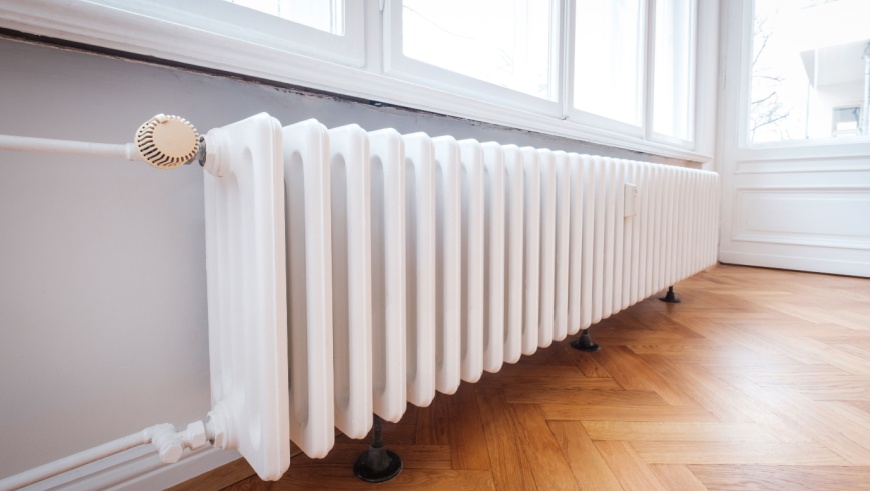
Table of contents
- How much to install a radiator?
- Additional radiator installation costs
- Labour cost to replace a radiator
- Factors that impact radiator replacement costs
- DIY radiator replacement
- Types of radiator
- What materials are radiators made from?
- Cost of radiator removal
- FAQs
- How to find & hire a radiator installer
How Much to Install a Radiator?
The average cost to replace a radiator is typically around £200 for a traditional double panel radiator.
The price varies depending on the quality and size of the radiator, whether any brackets need to be changed, and how much pipework is required.
There are several types of radiators available:
- Standard
- Column
- Cast iron
- Vertical
- Designer
Standard Radiator Cost
Standard radiators come in various sizes to suit different-sized rooms. A 500mm x 600mm double radiator costs on average £30-£40, a TRV (thermostatic radiator valve) costs between £10-£30 depending on style and brand and labour will cost around £20-£25 per hour.
After installation, use a radiator bleed key to open the bleed valve and release trapped air, which can create cold spots and affect performance.
Vertical Radiator Cost
Vertical radiators are tall radiators which have become fashionable in more modern homes. An average vertical radiator of 1800mm x 464mm costs approximately £250-£450 for a single flat panel design.
Selecting a radiator with identical pipe centres is crucial to simplify the removal and replacement process, avoiding the need for additional plumbing adjustments. Cast iron radiators are popular in traditional style houses, and a plain style black finish 645mm x 396mm horizontal radiator will cost around £150-£200.
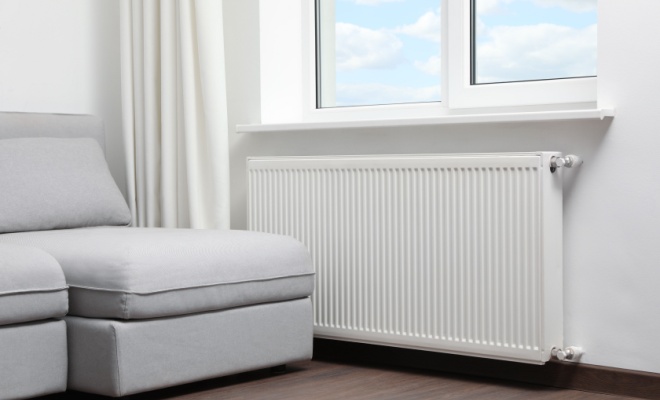
Column Radiator Cost
Column radiators come in modern and traditional designs as well as a range of sizes. An average-sized 600mm x 1010mm horizontal column radiator costs in the region of £250-£350. When installing, it is essential to replace existing brackets with new radiator brackets to ensure compatibility and address any gaps left from previous installations.
Designer Radiator Cost
Designer radiators feature a wide range of designs, shapes and concepts. They range from traditional cast iron to modern mirror radiators, horizontal and vertical, rectangular, oval and wave designs. Prices range from £100 to more than £1,000. When replacing a radiator, it is important to ensure the new unit is set at the same flow rate as the previous one to maintain the system's overall efficiency and performance.
What else can affect the cost of radiators?
Aside from the type of radiators available, there is a variety of materials that radiators are constructed from. Some heat more quickly while others retain residual heat for longer.
Stainless steel, aluminium, copper, and cast-iron radiators come in an array of modern, designer, traditional and bespoke designs.
Radiator Fitting Cost List
Below are some estimated costs associated with replacing a radiator:
| Job Type | Average Cost |
|---|---|
| Replace a Standard Radiator | £200 |
| Replacing an Electric Radiator | £80 |
| Remove a Standard Radiator | £100 |
| Install an Additional Radiator | £300 |
| Replace All Radiators (3 Bed House) | £1300 |
One extra that may need to be added to your new radiator cost is bleeding radiators across the home to ensure the system is running effectively. Bleeding standard radiators can take between 30 minutes and 1 hour, usually costing around £100.
How Much Do Radiators Cost?
Here are some radiator costs based on buying standard radiators separately (no installation included):
| Size | Avg. Price |
|---|---|
| 400mm x 400mm | £30 - £45 |
| 300mm x 1000mm | £40 - £55 |
| 400mm x 1200mm | £45 - £60 |
| 600mm x 1200mm | £60 - £75 |
Bear in mind that these are only the supply costs for standard basic radiators. Prices will increase depending on what materials and sizes you choose.
Additional Radiator Installation Costs
Here are some additional costs you may need to consider:
Power Flush
When replacing or installing a radiator, it may be advisable to carry out a power flush of the system. Removing a radiator will inevitably disturb particles which can clog the system, so taking the precaution of cleaning the system should reduce the possibility of blockages.
Even without moving, radiator sludge will build up in most central heating systems and eventually reduce the efficiency and effectiveness of the radiators. It can also lead to damage to the boiler, and you may have to replace it sooner than you would if the system were regularly cleaned through.
The average cost of a power flush is £400, although the cost does depend on the number of radiators and the type of central heating system.
Central Heating Inhibitor
An inhibitor is a chemical which is added to the water in the central heating system to coat the pipework and reduce the amount of corrosion and rust. The use of an inhibitor can reduce the likelihood of sludge and rust building up in the system and causing blockages in your radiators. It is often used as part of a power flush.
A litre of inhibitor costs around £15-£30 but you should consult your heating engineer or plumber if you are unsure how to use it.
Replacing a Skirting Board
Skirting boards can be damaged when installing a radiator and may need to be replaced. If the existing skirting can be matched, then it should only be necessary to replace the affected piece.
However, if the skirting board has been in place a long time, it may be difficult to match, and the decision is to either remove all the skirting or pay for a matching profile to be made.
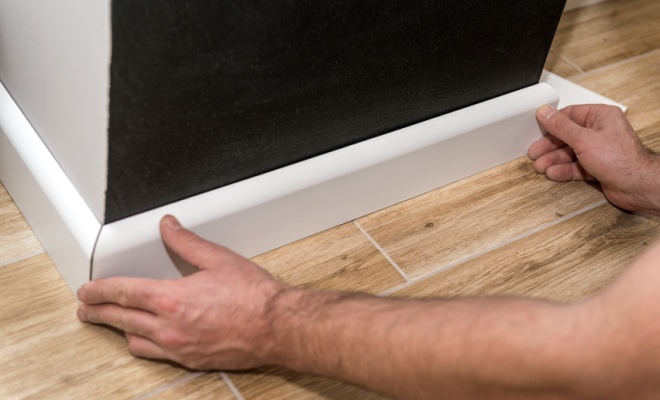
A 3-metre length of 150mm Victorian oak skirting board will cost on average £40. To hire someone to replace the skirting will cost approximately £150-£200, depending on the experience of the carpenter and location in the UK.
Replacing Floorboards
The cost to move a radiator to another wall in the same room may include the replacement of floorboards. The price you can expect to pay for the replacement of some floorboards is approximately £250 and should take no more than one day to complete if there are no complications.
You may want to save some money by removing the floorboards yourself, but you may not know which way the pipes are running in the room, and unnecessarily remove boards. Of course, once the work is done, then you can replace the boards yourself to avoid paying a carpenter.
Re-Plastering
If a radiator has been replaced as part of a refurbishment or renovation, then the room may also require plastering. This is not the easiest of DIY jobs, so it is worthwhile getting an experienced plasterer to do the work. It is not cheap, but the finish will be professional and worth the cost.
The average cost of a plasterer is £150-£250 per day, depending on where you are in the UK.
Painting and Decorating
Painting and decorating may be necessary if you have had to plaster or re-plaster a room or a wall after installing a radiator. If you do not want to do it yourself, you should budget for between £160-£200 per day for a decorator.
New Boiler
Over time, as your central heating system ages, deposits can accumulate in the pipework and radiators, and this can affect the performance of your boiler. If a new boiler as well as a new radiator is needed, you should expect to pay between £1,250 and £1,800 for this, depending on which type of boiler you install.
A bigger expense would be the installation of a full new heating system, which has a price tag of around £4,000 for a 3-bed house.
Cost to Remove a Radiator for Decorating
The average cost to move a radiator for access to decorate and then refit afterwards will typically be around £100 and will include checks post-fitting to ensure all is well and there are no leaks.
A good plumber will test the radiator before leaving the property by making sure that it heats up properly with no cold spots. This work should be done in no more than an hour.
Removing a radiator to paint the wall behind may seem like the kind of DIY job that can be done to save money, and if you are confident and careful, then it can be done. The radiator needs to be drained and the TRVs, if fitted, capped off.
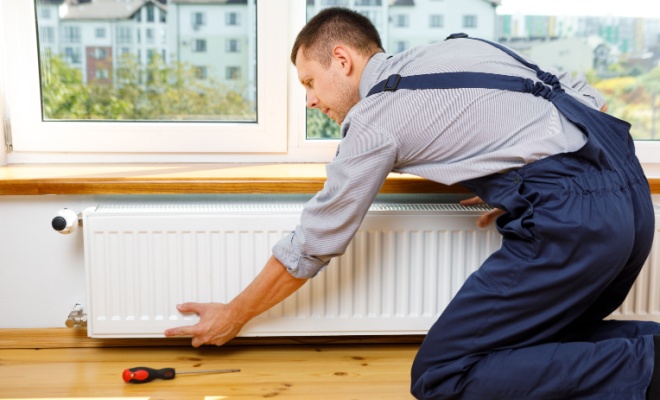
The radiator can then be lifted off its brackets and any remaining water drained into a bucket. Once the wall is dry, the process is reversed, but it will be necessary to bleed the radiators as air will have gotten into the system.
The process of radiator removal can be complex, especially with intricate engine designs or additional components, and may require a radiator bleed key to release trapped air.
Cost to Remove a Faulty or Damaged Radiator
To replace a faulty or damaged radiator, like-for-like, with a TRV installed, prices start at around £200. This assumes no complications or added services such as a power flush. To swap the new for the old radiator can be done within a day, also allowing for testing after fitting.
Cost to Install an Additional Radiator
You may decide to install an additional radiator if a room is too cold. Your plumber may need to lift up the carpet or wooden flooring and the floorboards if extra pipework is needed, and this will add to the cost. A budget of around £230 should be enough, including the new radiator cost.
It is also worth checking that your existing boiler can cope with an extra radiator. Most boilers will be able to cope with one or two extra radiators, but you need to consult a heating engineer or plumber to make sure that installing a radiator will not overburden your boiler. The timeframe for this work will be 1-2 days.
Radiator Installation Cost Breakdown Calculator
Individual costs to replace a single double panel radiator - Total Cost: £200
Materials
£80
Labour
£120
Waste
£0
Labour Cost to Replace a Radiator
The labour cost to replace a radiator will include the removal of the existing radiator and the fitting of the new one. A plumber or heating engineer will either charge by the hour, day or give a set price.
Most heating engineers work in pairs for safety reasons and usually charge around £300 per day for a team of 2. If the job is small, then quite often only one tradesman will be required, so you can expect a cost of around £150 to £200 per day in labour.
Hourly rates on average are between £25 and £40, again depending on location and experience.
How Long Does Radiator Replacement Take?
The overall time to complete the job will be around 2 to 3 hours, with the heating engineer usually carrying out tests on the radiator to ensure no minor repairs are required, as well as fixing any minor leakage.
Here are some estimated time frames for installing radiators:
| Job Type | Duration |
|---|---|
| Replace a Standard Radiator | 1-2 Hours |
| Replacing an Electric Radiator | 1-2 Hours |
| Remove a Standard Radiator | 1-2 Hours |
| Install an Additional Radiator | 3-4 Hours |
| Replace All Radiators (3 Bed House) | 1-2 Days |
Factors That Impact Radiator Replacement Costs
Here is a list of factors that may affect the overall cost:
Size of Radiator
The size of the radiators that you intend to fit will have a direct impact on the price that you pay. However, the size is not what dictates the suitability of a particular radiator. Determining which radiator will most efficiently heat a room is done by calculating the BTU or British Thermal Unit.
A BTU is a unit of heat defined by the amount of energy required to raise the temperature of a pound of water by one degree Fahrenheit, and all radiators are measured in this way. You can use this radiator size calculator to ensure you buy the right size for the room.
Type of Radiator
There are several types of radiators on the market and, apart from calculating the BTU, you will need to choose the appropriate type. The most common radiator in homes is connected to the central heating with the hot water for the radiators being heated by the boiler.
There are electric radiators, which are mounted on the wall and plugged into a wall socket which are filled with a fluid that is heated by an electrical element within the radiator.
Dual fuel radiators can be powered by the central heating but also have an element fitted so that it can be used independently of the central heating system, for example in the summer.
Style of Radiator
Within these variations, there are several styles of radiator. The most diverse range is those that are connected to the central heating of the property and includes single panel, double panel, convector, column, horizontal and vertical radiators.
Of course, there is a wide variety of designer radiators available, constructed from different materials and offering unusual designs and styles.
Moving a Radiator
If it is necessary to move a radiator from one location to another, then there may be extra costs involved. New pipework may need to be laid, flooring may have to be removed for the work to be carried out, and this will add both to the material and labour costs.
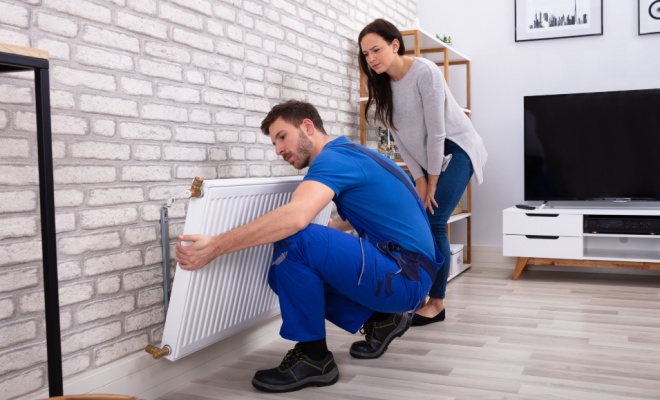
Number of Radiators
Obviously, if you are replacing more than one radiator, the cost will rise depending on the number of radiators and the type that you are replacing them with.
Quality of Radiator
The quality of a radiator will influence how much you pay by as much as 50% with designer and high-end products costing much more. This will be due to the material used, the efficiency of the radiator and the design.
Adding Additional Radiators
Be aware that if you install additional radiators, it may be prudent to check that your current boiler can cope with the extra workload. If the boiler is more than ten years old, you may want to consider replacing the boiler as part of the work. For this, you should consult a heating engineer.
Fitting Thermostatic Radiator Valves
Fitting TRV valves will allow more efficient control of the room and radiator temperature and can potentially save on fuel bills. Thermostatic Radiator Valves (TRV) control the radiator’s temperature by sensing the room air temperature and automatically opening and closing the water flow to the radiator to maintain a pre-set temperature.
TRVs are now a requirement as part of Building Regulations in homes, but many older properties still do not have them. Check with your installer to make sure you have the correct valves. The cost of TRVs ranges from less than £10 to more than £35 and should take no more than an hour for a plumber or heating engineer to fit.
Boiler Replacement
When replacing a radiator, you should think about the boiler capacity and efficiency: if the boiler is more than 10 years old, it may be worth replacing it too. The average cost to replace a boiler is between £1250-£1800 depending on the brand and type of boiler fitted.
Insulating Your Home
Finally, there is no point in having efficient radiators if your house is poorly insulated. Insulate the loft to at least 150mm of modern insulation and investigate double glazing if you do not have it already fitted.
DIY Radiator Replacement
There are many reasons why you may want to replace a radiator, leaks, upgrades, or energy efficiency, and there are many guides available on how to replace a radiator. Considering a DIY radiator replacement can be a viable alternative to hiring professionals, but it's important to weigh the pros and cons of both approaches.
If you lack plumbing experience, professional assistance is advisable, whereas those with prior skills may successfully undertake the task on their own.
Leaking Radiator
Radiator leaks come from one of four places: the body of the radiator itself (if old and rusted), the bleed point, the valve or the water pipe leading to the radiator. If you have just replaced or refitted a radiator, the joins between pipes, valves and the radiator itself are the most likely culprits.
Upgrading Your Radiator
Upgrades may require professional advice as there may be a difference between the existing and new pipework, or the new radiator may put a strain on your existing central heating system, which may need servicing or perhaps a new boiler.
You can carry out the radiator replacement yourself but getting professional guidance is recommended if not replacing like for like.
Energy Efficiency
If the radiators are hot at the top and cold at the bottom, this usually means that the radiator is receiving an insufficient flow of water. This can be caused by a few things including a blockage in the radiator and faulty or incorrectly specified water pump in the central heating system.
Bleeding the radiator often eliminates this problem but if it is a recurrent issue then it may be necessary to replace the radiator for a newer and more efficient one.
Tools and Safety Equipment for Replacing a Radiator, including Radiator Bleed Key
It is possible with some instruction for a radiator to be replaced as a DIY job and can be done with the following tools:
- Spirit level: £10-£20
- Adjustable wrench: £6-£60
- Spanner: £3-£80
- Plastic bowl: £1-£5
- Rags: £1-£2
- Radiator key: £0.80
- Tape measure: £5-£30
- Screwdriver: £5-£65
Although there is little risk involved in replacing a radiator it is advisable to wear gloves (£2-£5), to protect your hands and safety boots (£17-£120) in case the radiator is dropped on your feet.
Even if you need a plumber or heating engineer to install your new radiator you could save some time and money by removing the old one yourself. However, you should speak to your plumber beforehand and ensure that they are happy for you to do this and that they will still guarantee the work of installing the replacement radiator.
Types of Radiator
There are quite a few types of radiators to choose from including horizontal, column, vertical and electric radiators. There are also single and double panel radiators as well as double convector radiators. Which you choose depends on what is best for your room, your heating system and your own personal preference.
It is also important to choose a radiator size that will sufficiently heat your room. Here is a radiator size calculator which is handy to use when choosing a new radiator to adequately and efficiently heat a room.
Single Panel Radiator
Single panel radiators are the simplest and are basically a hot water container that radiate heat out into a room. They normally have convector fins at the back to increase the total surface area for air to come into contact with and be heated.
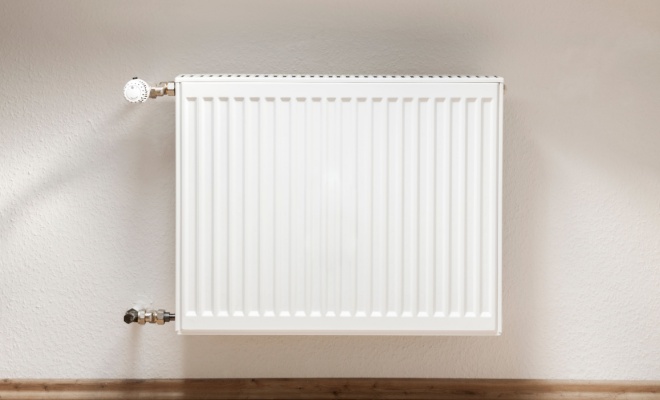
This warm air is then circulated around the room by convection, the process by which cold air sinks, is heated by the radiator and then rises. This air eventually cools down and sinks allowing the cycle to begin again. Similarly, a car radiator plays a crucial role in maintaining the engine's optimal temperature, and its longevity, repair, and replacement costs are important factors to consider.
Pros:
- ✔ Small and can fit in confined spaces.
- ✔ Simple to install and maintain.
- ✔ Available with convection fins for increased heat output.
Cons:
- ✖ Not as effective as double panel radiators.
- ✖ When fitted with convector fins will not sit flat against the wall.
- ✖ Will only be effective in small rooms.
Double Panel Radiator
Double panel radiators are similar to a single panel but have an additional panel on the back, thereby encasing the convector fins in the middle. The increased surface area creates additional heat for the room.
Pros:
- ✔ Two panels produce more heat than a single panel.
- ✔ A room with a double panel radiator will be heated more quickly.
- ✔ Available in a wide variety of sizes and designs.
Cons:
- ✖ Greater wall space is required.
- ✖ Not suitable for tight or confined spaces due to added width.
- ✖ Will require greater performance from your boiler.
Double Panel Double Convector Radiator
A double panel, double convector radiator has two sets of convector fins in the middle of two panels. This creates even more heat than a double panel radiator and is suitable for large rooms.
Pros:
- ✔ With twice as much surface area the radiator will radiate more heat.
- ✔ Suitable for large rooms.
- ✔ The desired room temperature will be reached quicker.
Cons:
- ✖ Additional width means they require more space.
- ✖ Can look cumbersome compared to slim panel radiators.
- ✖ Unless correctly calculated they may be producing more heat than required for the room and therefore not be energy efficient.
Horizontal and Vertical Radiators
Horizontal and vertical radiators come in a variety of designs and styles and are named for the direction in which they are hung, i.e. with the greatest length on the horizontal or vertical plane.
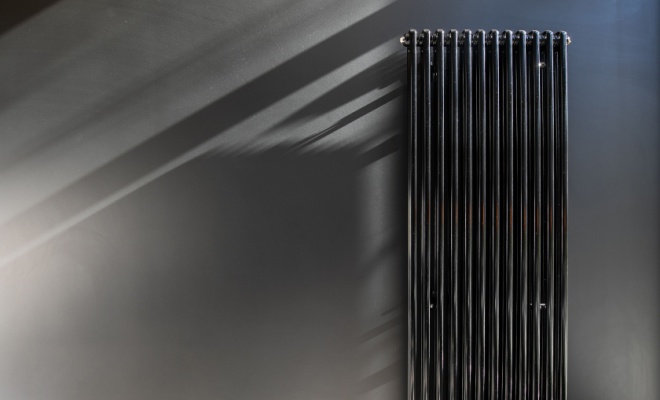
Most traditional radiators are horizontal, but the popularity of vertical radiators has been due to the ability to fit these radiators into spaces that would otherwise have been unsuitable for a large radiator.
Pros:
- ✔ Available in a wide range of sizes, designs and styles.
- ✔ Ideal to place underneath windows to capture cooler air coming into the room.
- ✔ Equally suitable in traditional, modern or commercial settings.
Cons:
- ✖ Can appear uninspiring and old fashioned.
- ✖ Not suitable for areas with reduced wall space.
- ✖ Location within a room can be limited as it takes up a lot of wall space that could otherwise be used for furniture.
Column Radiators
Column radiators can be made from steel, cast iron or other metals such as aluminium and are formed by joining tubular sections together to a required length. This has the advantage of being adaptable to many sizes and for transportation where they can be assembled on site.
Pros:
- ✔ Classic look that is suitable in both modern and traditional homes.
- ✔ More surface area than a panel radiator so will give off more heat and rooms are heated quicker.
- ✔ Available as horizontal or vertical radiators.
Cons:
- ✖ Cleaning between the columns can be challenging.
- ✖ May take up a lot of space in smaller rooms.
- ✖ When constructed from cast iron they can take a long time to heat up.
Electric Radiators
Electric radiators contain a thermodynamic fluid that is heated by an element within the radiator and this heat is released into the room. They are wall mounted and relatively easy to install as a DIY project.
Pros:
- ✔ Can be used independently of a main heating system.
- ✔ Suitable for properties that are not connected to mains gas supply such as in remote areas.
- ✔ Low maintenance required and can be controlled with an app on a smartphone or tablet.
Cons
- ✖ More expensive to run than conventional radiators.
- ✖ Limited styles and designs.
- ✖ Larger rooms may require more than one electric radiator.
What Materials are Radiators Made From?
Your new radiator cost will be affected by the material it's made from.
Here are some common radiator materials and how their pricing adds up:
Stainless Steel
Stainless steel radiators giving a highly polished and reflective surface are available as horizontal and vertical heaters. A 600mm x 590mm horizontal stainless steel polished finish radiator will cost £250 to £350 on average.
| Radiator Size | Avg. Price Range |
|---|---|
| 600mm x 413mm | £225 - £275 |
| 600mm x 1003mm | £300 - £350 |
| 1800mm x 280mm | £650 - £700 |
| 1500mm x 490mm | £700 - £750 |
Aluminium
Aluminium is an excellent heat conductor and therefore makes an excellent radiator material. A 1800mm x 412mm single panel aluminium vertical radiator costs approximately £200 to £250.
| Radiator Size | Avg. Price Range |
|---|---|
| 557mm x 660mm | £150 - £175 |
| 1800mm x 470mm | £200 - £250 |
| 600mm x 710mm | £250 - £300 |
| 2046mm x 360mm | £300 - £350 |
Copper
Copper radiators are adaptable to modern, traditional and industrial settings. A 592mm x 701mm copper horizontal radiator costs, on average, £300 to £400.
| Radiator Size | Avg. Price Range |
|---|---|
| 500mm x 400mm | £300 - £400 |
| 1000mm x 500mm | £450 - £600 |
| 1200mm x 600mm | £600 - £750 |
| 1800mm x 600mm | £800 - £1,000 |
Cast Iron
Cast iron radiators are usually found in more traditional settings and they have excellent heat retention capacity. A 780mm x 758mm decorative cast iron radiator costs in the region of £250 to £350.
| Radiator Size | Avg. Price Range |
|---|---|
| 450mm x 334mm | £100 - £150 |
| 750mm x 329mm | £200 - £250 |
| 350mm x 718mm | £400 - £450 |
| 750mm x 1170mm | £500 - £600 |
Cost of Radiator Removal
There are several situations when we would need to remove a radiator. Decorating is the most common, followed by replacing the floor or skirting boards, adding silver foil reflectors, and of course replacing a radiator with a new one.
It is not a difficult job if you have patience and take sensible precautions. But there are things that can go wrong, the most common being the radiator leaks when fitted or refitted.
To find and repair radiator leaks first put some towels on the floor around the radiator and then completely dry the surface of the radiator to find the source of any leak. Once the radiator is dry you should be able to see the source of the leak easily. If not, then take some paper towel and systematically check every union on the radiator.
As discussed, it is possible to remove a radiator as a DIY job with relative ease. If, however it is not something that you are confident about tackling then you should hire a plumber to do it. The average cost to hire a professional to just remove a radiator is on average £100.
If you need to dispose of an old radiator you could contact a local scrap metal dealer and arrange collection, or you could take it to your local recycling centre free of charge. Make sure it is completely empty of water before you put it in your car though.
FAQs
To begin bleeding the radiator first of all turn off the heating to avoid burning yourself, then using a radiator key and a cloth, simply turn the valve slowly until a small amount of water and air comes out. Once water starts coming out without spluttering or bubbles, close/tighten the valve and move onto the next radiator, working your way around the house.
Once done, check the water pressure in the central heating system, it may need topping up. Now switch the central heating back on and check all the radiators for cold spots, repeating the process as necessary for any radiators that still have cold spots. If all of this sounds like too much work, a plumber would typically charge around £100 to bleed the radiators in a typical 3-bed semi-detached house.
Air can get trapped in radiators and displace the hot water which normally heats them. This can be fixed by bleeding the radiator.
TRVs can get stuck especially if they are old so this may need to be investigated as a reason. Another reason could be that the water pressure has dropped so the system may need topping up. The pressure in a domestic boiler should be around 1 bar and this is normally displayed on the boiler. it is possible to top up the water by means of the cold-water feed on the boiler until the desired pressure is achieved.
If none of these are the reason for the cold radiator it may be necessary to contact a heating engineer or plumber to find the cause.
It is also usually the coldest part of a room, the cooler air that enters from the window area is heated by the radiator and rises creating a convection air current that heats the room.
How to Find & Hire a Radiator Installer
Not everyone will know how to replace a radiator or be confident about doing so and it may be necessary for some people to hire a professional plumber or heating engineer to carry out this work.
Therefore, it is important to know how to find and hire a radiator installer to replace a radiator for you.
- There is no substitute for personal recommendation and if you can source a plumber or heating engineer that you either know or that family and friends have successfully used then that is half the battle.
- Heating engineers need to be Gas Safe registered to work on a central heating system and this requires Gas Assessment Training (ACS) certification.
- They should also have an industry qualification such as an NVQ Level 2 and 3 in Mechanical Engineering Services-Plumbing (Domestic) or Diploma in courses like Domestic Natural Gas Installation and Maintenance, Gas Utilisation or Domestic Plumbing and Heating.
- A heating engineer or plumber will require an Unvented Hot Water Certificate to work on a sealed system which is one with a combination boiler or without a water storage tank in the loft.
- Ask what insurance they have and ensure that it will cover the work that they are doing. Be aware if they are not certified to carry out the work any insurance, they have may be void so check their credentials first.*
*This can be done by asking first to see their Gas Safe photo ID with their own unique license number. If they claim they do not have it with them then do not allow any work to be done until you have seen it and checked it against the Gas Safe register.
The rear of the ID card should list all the appliances that the heating engineer can work on.










